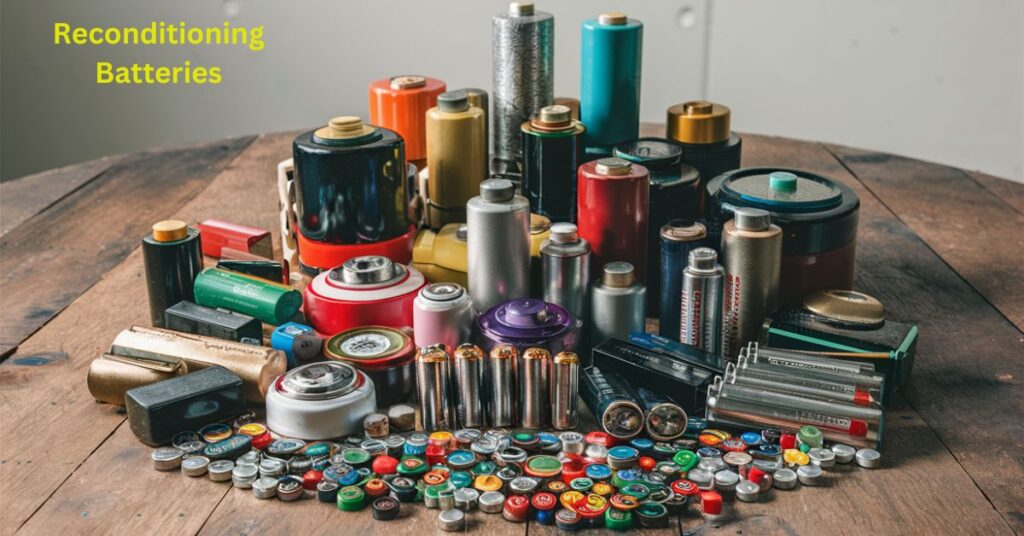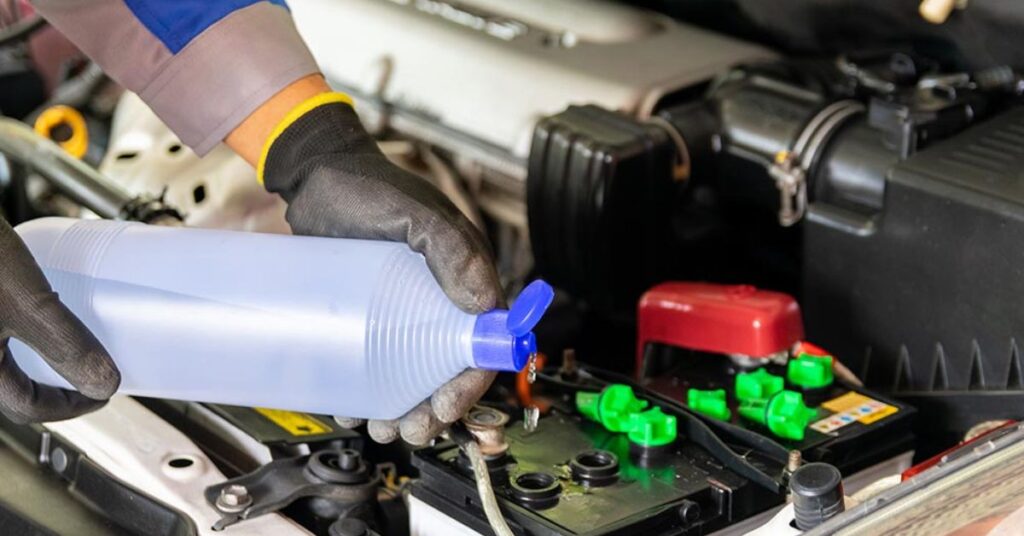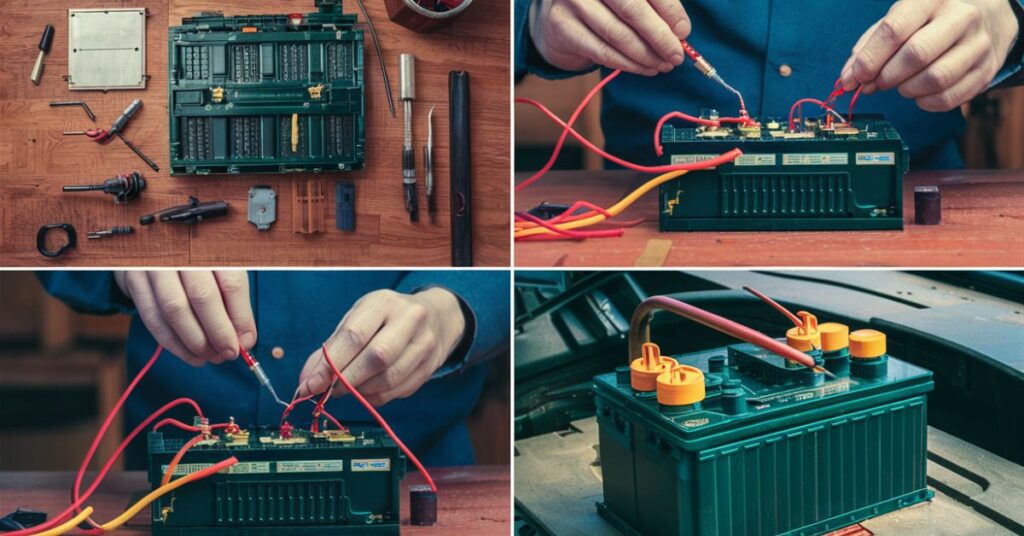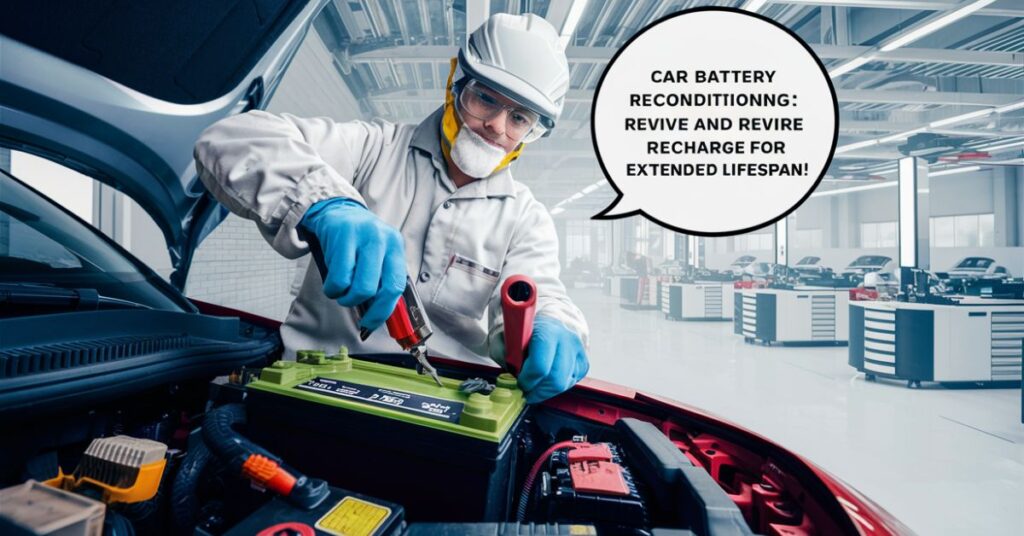Car trouble? Don’t jump to replacing that battery just yet! Car battery reconditioning might be your secret weapon to save money and extend the life of your trusty vehicle. This process aims to breathe new life into a tired battery by cleaning it out, addressing imbalances, and essentially giving it a workout to restore its capacity. Think of it as a spa day for your battery!
But hold on a sec, reconditioning isn’t quite a walk in the park. It can involve some technical steps and safety precautions. Before you dive in, we’ll explore the how-tos, the why-tos, and some important considerations to help you decide if reconditioning is the right road trip for your battery. So, buckle up, gear up, and get ready to learn all about giving your car battery a second chance!
What is Battery Reconditioning?
Battery reconditioning is a process aimed at restoring the capacity of a rechargeable battery that has lost performance over time. This is typically caused by the build-up of lead sulfate crystals on the battery’s plates, which hinders its ability to store and release energy effectively.

Traditionally, reconditioning involves a controlled deep discharge of the battery, followed by a full recharge. This process can help to break down some of the lead sulfate crystals, allowing the battery to hold more charge.
However, it’s important to note that reconditioning isn’t always successful, and its effectiveness depends on the severity of the battery’s degradation. Here’s some new information to consider:
Modern Battery Chemistry: The reconditioning process described above is more applicable to older lead-acid batteries. Lithium-ion batteries, which power most electronics today, degrade differently. While some methods are being explored to revitalize lithium-ion batteries, they are still under development and not widely available.
Prevention is Key: The best way to extend the lifespan of any battery is to practice good charging habits. Avoid letting batteries completely drain, and opt for cooler charging environments whenever possible. Following these steps can significantly reduce the need for reconditioning altogether.
Safety First: If you decide to attempt reconditioning at home, thorough research on the specific type of battery and safety precautions is crucial. Disassembling or mishandling batteries can be dangerous, so it’s often advisable to consult a professional or replace the battery entirely.
What is Reconditioned Car Batteries
Reconditioned car batteries are pre-owned batteries that have undergone a process to restore their functionality and performance. While the core concept remains the same, advancements in technology have led to more sophisticated reconditioning methods. Let’s examine deeper:

Traditional Reconditioning: This involves cleaning the battery casing, replacing defective components like terminals, and subjecting the battery to controlled discharge and recharge cycles. This helps break down some lead sulfate crystals, improving the battery’s ability to hold a charge.
Advanced Techniques:
Equalization Charging: This uses specialized equipment to identify and address imbalances within the battery’s cells. By providing targeted charging to weaker cells, the overall capacity and lifespan are improved.
Pulse Charging: High-frequency pulses are delivered to the battery, dislodging stubborn lead sulfate crystals and improving the flow of electricity within the cells.
Capacity Testing: Modern reconditioners employ advanced diagnostic tools to precisely measure a battery’s remaining capacity after reconditioning. This allows for more accurate assessments of its suitability for your vehicle.
Why People Throw their Car Batteries Right Away
Ever stared at a dead car battery with a sinking feeling? It’s a common experience, and most people just head straight for a replacement. But why do so many people toss their old batteries without a second thought? Let’s explore the reasons behind this habit, and see if there might be a smarter way to handle your worn-out battery.

Convenience Can Be Costly
Replacing a car battery is a relatively quick fix. You can often get it done at the same place you buy a new one, and sometimes it’s even included in roadside assistance plans. This convenience factor is a big reason why many people opt for a straight swap. But what they might not realize is that there could be other options.
Lack of Awareness: Recycling is a Viable Choice
Most people don’t know that car batteries are actually classified as hazardous waste. Lead, acid, and other nasty chemicals lurk inside those casings, and improper disposal can seriously harm the environment. The good news? Car batteries are also one of the most recycled consumer products out there! Recycling captures those harmful materials and puts them to good use in new batteries or other products.
Misconceptions about Reconditioning
Some folks might think reconditioned batteries are unreliable or weak. While that may have been true in the past, with advancements in technology, reconditioning techniques can now restore a battery closer to its original capacity. So, a reconditioned battery could be a perfectly good option for some vehicles.
So, What Should You Do With Your Old Battery?
Here’s the smart move: Don’t just toss your old battery in the trash! Instead:
Recycle It: Find a local battery recycling center or ask your mechanic where to take it. Many auto parts stores also accept used batteries for recycling.
Consider Reconditioning: If your battery isn’t too old and extremely damaged, explore reconditioning as a more budget-friendly option.
By recycling or reconditioning your car battery, you’re helping the environment and potentially saving yourself some cash. It’s a win-win.
Read This Blog: What Does the Check Fuel Cap Warning Light Mean?
Is battery reconditioning advantageous?
Battery reconditioning can be a great way to save money and extend the life of your car battery. However, it’s important to weigh the advantages and disadvantages before deciding if it’s the right option for you.
| Advantages | Disadvantages |
| Saves Money | Not All Batteries Respond Well |
| Environmentally Friendly | Requires Expertise or Research |
| Potentially Restores Battery Performance | May Not Be As Reliable as New Battery |
Let’s break down these advantages and disadvantages in more detail:
Advantages:
Saves Money: Reconditioned batteries are significantly cheaper than new batteries. This can be a major advantage, especially if you’re on a tight budget.
Environmentally Friendly: A reconditioning battery keeps them out of landfills and reduces the need to manufacture new batteries, which require a lot of energy and resources.
Potentially Restores Battery Performance: With advancements in technology, reconditioning techniques can now restore a battery closer to its original capacity. So, a reconditioned battery could be a perfectly good option for some vehicles.
Disadvantages:
Not All Batteries Respond Well: Not all batteries are good candidates for reconditioning. Batteries that are too old or severely damaged may not respond well to the process.
Requires Expertise or Research: To recondition a battery yourself, you’ll need some expertise or do some research on the process. If you’re not comfortable doing this yourself, you’ll need to find a reputable battery reconditioner.
May Not Be as Reliable as New Battery: Reconditioned batteries may not be quite as reliable as a brand new battery. This is especially true for batteries that have been through multiple reconditioning cycles.
So, is battery reconditioning right for you?
It depends on your individual circumstances. If you’re on a tight budget and your battery isn’t too old, reconditioning could be a great option. If you’re looking for the absolute best performance and reliability, a new battery might be the better choice.
Also Read This Blog: How to Find Catalytic Converter Scrap Value by Serial Number?
How to Recondition a Car Battery at Home
While it’s possible to recondition a car battery at home, it’s important to acknowledge the risks and limitations before diving in. Reconditioning involves handling hazardous materials and requires specific tools and knowledge. Here’s a breakdown of the process but it is strongly recommended to consult a professional or purchase a replacement battery if you’re not comfortable or lack the necessary equipment.

Here is Step-by-Step Guide to Reconditioning a Battery,
Safety First!
Wear safety glasses and gloves when handling the battery, as acid spills can cause serious injuries.
Work in a well-ventilated area, as battery acid fumes can be harmful.
Have baking soda on hand to neutralize any accidental acid spills.
Tools and Materials
Baking soda
Water
Distilled water (for refilling the battery)
Funnel
Eye protection and gloves
Battery charger (with low amp output)
Voltmeter
Wrench (to loosen battery terminals)
Further Steps (proceed with caution)
Battery Removal: Carefully remove the battery from your car following the proper procedures outlined in your car’s manual.
Cleaning the Battery: Mix a baking soda and water solution to create a paste. Use this paste to clean the battery terminals and casing, removing any corrosion.
Neutralize Spills: If any acid spills occur, immediately flush the area with a baking soda and water solution.
Discharge (Optional): Some methods involve discharging the battery completely before reconditioning. This can be risky and requires expertise, so proceed with caution if attempting this step.
Electrolyte Replacement (Not recommended for beginners): This involves removing the battery caps (if possible) and replacing the old electrolyte solution with a new one made from distilled water and Epsom salts. This step is risky and requires specific knowledge about your battery type.
Charging: Using a battery charger with a low amp output (around 2 amps), recharge the battery for 24-36 hours. Monitor the voltage regularly using a voltmeter.
Testing: Once fully charged, turn off the charger and let the battery rest for a few hours. Then, use a voltmeter to check the battery voltage. A reading of 12.4-12.7 volts indicates a good reconditioned battery.
Important Considerations
Age of Battery: If your battery is several years old or severely damaged, reconditioning may not be effective.
Expertise Needed: Reconditioning, especially steps like electrolyte replacement and requires knowledge and experience to perform safely and correctly.
Safer Alternatives: Weigh the risks involved in reconditioning against the simplicity and safety of purchasing a new battery.
Remember, reconditioning isn’t always successful and can be dangerous if not done properly. If you’re unsure or uncomfortable with any steps, it’s best to leave it to a professional or opt for a new battery.
Watch the video below to have practical knowledge on how to recondition a car battery:
Curious to see this process in action? The video below takes you through the steps of reconditioning a car battery at home!
How long does it take to recondition a car battery?
The time it takes to recondition a car battery depends on a few factors, but here’s the latest info to set your expectations:
Typical Range: Generally, reconditioning a car battery takes anywhere from 24 to 72 hours. This timeframe assumes you’re using a low amp charger and following a standard process.
Factors Affecting Time: The severity of the battery’s degradation and the specific reconditioning technique used can influence the total duration.
Deep Discharge: If the process involves a complete discharge before charging, it will add extra time (potentially several hours) to the overall reconditioning process.
Advanced Techniques: Some advanced methods, like pulse charging may take less time than traditional methods because they work more efficiently.
Key Takeaway: Patience is key! Reconditioning isn’t a quick fix – it’s a process that takes time to ensure the battery is properly restored.
Conclusion
Thinking about giving your car battery a second life? Reconditioning can be a tempting option, especially if you’re on a tight budget. The process involves cleaning the battery, potentially discharging it completely, and then recharging it using a special technique. Sounds straightforward, right? Well, hold on a sec.
Reconditioning can get complicated fast. It requires safety gear, specific tools, and handling hazardous materials like battery acid. Even then, success isn’t guaranteed. Older batteries or those severely damaged might not respond well to reconditioning.
Bottom Line: Consider the Risks and Rewards
Before diving into reconditioning at home, weigh the risks and rewards. If you’re not comfortable with the process or lack the necessary equipment, it is smarter and safer to replace the battery or seek professional help. Remember, a new battery offers guaranteed performance and peace of mind on the road.
Frequently asked Questions
How do I bring my car battery back to life?
If your battery is just drained, a jump start from another car might be enough. For a potentially revived battery, consider complete reconditioning.
How do I start my car battery again?
Use jumper cables and a running car to transfer power to your dead battery. Follow proper procedures to avoid damage.
Does battery reconditioning really work?
It can! But success depends on the battery’s condition. Advanced reconditioning by professional offers better results.
How long will a reconditioned battery last?
It varies. Reconditioned batteries might last a few years, but a new battery generally offers a longer lifespan.







